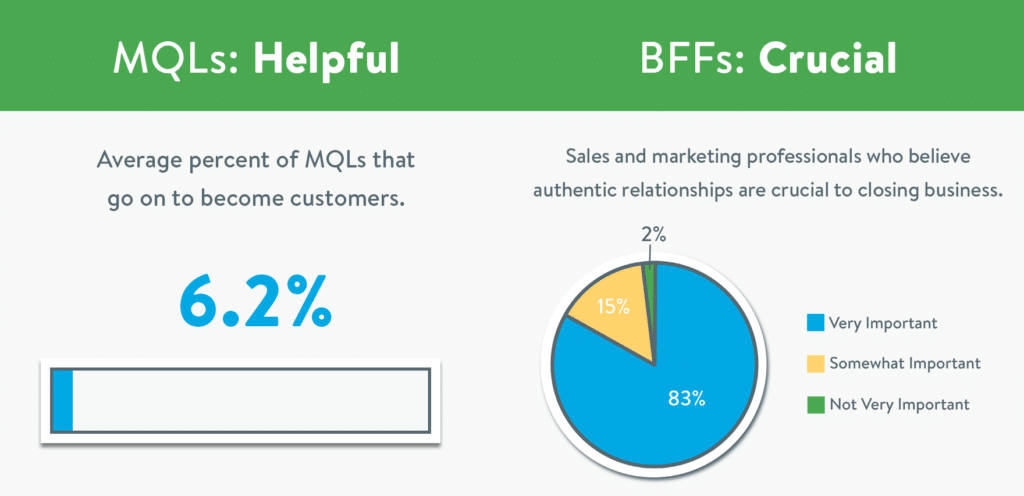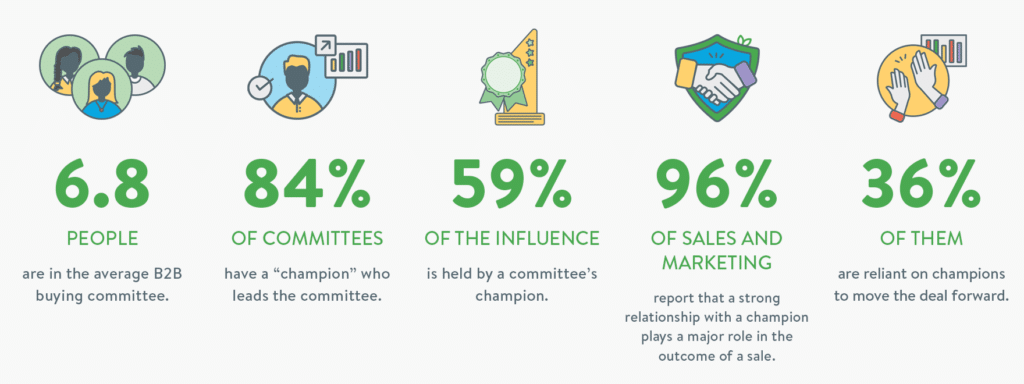This is the first in a series of blog posts where we recount the Sigstr sales and marketing team’s transition to using relationships as our key performance indicator.
BFFs Are the New MQLs
Don’t get a marketer started on their lead scoring framework and qualification process. Setting them up is complicated and often require a consultant’s help to make them function correctly. After that, weighting the behavioral and firmographic attributes is guesswork at best, and they require constant tinkering to keep them consistent with their sales team’s objectives.
And for all that work, what do we get? A sales team that’s either complaining that leads aren’t warmed up enough because the MQL (marketing qualified lead) threshold is too low or they’re not getting enough leads because it’s too high. But that’s not the worst part. After all that scoring, nurturing, flow-chart making, and eyebrow furrowing, those MQLs only turn into customers 6.2% of the time.
While MQLs are important for managing your funnel, they’re statistically crummy predictors of customer win rates. A more predictive indicator of customer win rates is relationship development. 98% of sales and marketing pros agree that an authentic relationship is a critical element of customer acquisition, according to research recently conducted by Sigstr and Heinz Marketing. But you didn’t need a statistic to believe that developing relationships is important to growing your business.

The Importance of Developing Relationships
Relationships have been important to businesses ever since the first shiny rock was traded for a sharp rock. But in the past ten years, relationship marketing made a huge resurgence in the form of Account-Based Marketing (ABM). ABM is, by definition, figuring out the people with whom you want to develop a business relationship with and then making it happen. A whopping 92% of companies consider ABM “extremely” or “very” important to their marketing program. To further the point, consider these additional statistics below:
- 81% of companies are going to be investing more in brand (which is the most difficult of all marketing ROI to track) over the next five years.
- The number of SDRs in existence has quintupled over the past ten years.
- Two thirds of companies are dedicating more than a quarter of their annual budgets to events and that amount is going to increase for 70% of companies next year.
What do all these things have in common? They’re all about developing relationships. Between your brand and your audience, and between your employees and the humans in your most important accounts.
This is why marketers need to spend less time driving MQLs and more time driving BFFs (best friends forever). But more than that, in an era where we’re oversaturated with brand messages and spammy communication, it just feels like putting relationships first is the right thing to do. This is something we put a finer point on in our Relationship Marketing Manifesto.
Measuring Relationships
Sigstr is beginning to orient our entire marketing program around relationships. Using our new B2B relationship intelligence platform, Sigstr Relationships, which leverages AI to quantify relationship strength based on recency, frequency, velocity and volume of communication. All with a dash of CRM data.
We’ll be monitoring relationship development across our 120 Tier One accounts and 1,500 Tier Two accounts, trying to understand what marketing campaigns move the needle across a variety of cohorts. We’ll be aligning sales and marketing efforts against these relationship scores to better understand pipeline development and to be more accurate around close rates. Lastly, we’ll be analyzing patterns and trends in relationship development to inform our ideal customer profile and account scoring framework so that we’re even better at making friends next time.
But first things first, if you’re going to scale anything, you need to know how to measure it. The Sigstr marketing team has identified four metrics to measure when trying to quantify a B2B relationship.
Spread
Definition: How many of “them” do “we” know (e.g. across all of Sigstr’s employees, we know 47 people that work at Oracle, so our spread is 47).
Why is spread important? Think of it as account penetration. The more people at a target account that know people at your company, the greater the mindshare, the easier to navigate the org chart, and the more influencers you’ll have in your corner.
How does marketing influence spread? Targeted display advertising through an ABM platform like Terminus lets you target specific companies (and even specific departments within those companies) with relevant messages to drive your awareness and lead gen efforts. A mass direct mail send addressed to a department or several specific people you haven’t contacted yet through a tool like Sendoso is also a sure way to gain some attention.
Scope
Definition: How many of “them” do “we” want to know (e.g. a buying committee or department within a target account).
Why is scope important? The average B2B buying committee has 6.8 people, which is up from 5.6 just a year ago. 84% of those committees have a “champion” who holds about 59% of the influence on that buying decision. Knowing who is in your buying committee and making sure you’re developing relationships with them is key.

How does marketing influence scope? This varies largely depending on what your typical customer looks like, but let’s look at Sigstr’s case: We sell to marketing teams, so our champion is typically a marketer. However, IT also needs to get involved to evaluate and implement and there’s generally an executive or two that wants to be part of the decision. We spend a lot of time analyzing and understanding the various personas in our scope so that we can deliver relevant content to them (we automate this through Sigstr).
Depth
Definition: A count of how many of “us” know an individual “them”.
Why is depth important? The more and stronger the connections between individuals in target accounts have with your company, the better they’ll understand your culture, have an easier time communicating, and have more support.
How does marketing influence depth? Because depth takes dedicated time from multiple personalities, this is more challenging to scale. Rather than trying to operationalize depth across the entire funnel, start to build workflows that trigger tasks assigned to certain people at certain opportunity stages. For example, when an account reaches a late opp stage (“budgeting” for example), set up a simple workflow that assigns a task to key executives on your team requesting that they send a personal message to the champion or committee.
Strength
Definition: This is a subjective measure of leverage and influence “we” have over an individual “them”.
Why is strength important? This one should be pretty obvious, but the more influence and rapport you have between people, the easier it is to help each other get what we both want. Strength is arguably the most important metric, but also the most difficult to quantify. How exactly do you make it measurable? If you take a step back and think about what makes a relationship successful, communication is the answer more times than not. So, measuring the amount of communication is a good place to start. While we’re measuring all of these metrics in Sigstr’s relationship intelligence platform, this is the metric we’re most excited to track.
How does marketing influence strength? To be honest, we’re not sure. We know how to track relationship development with Sigstr Pulse, but the best practices around deploying marketing campaigns with the goal of influencing relationships is something we’re in the process of figuring out. Stay tuned as we learn more in this area!
We’re going to spend the next three months pouring over the metrics mentioned above as we compare their movement to the sales and marketing tactics we use to influence them. We’ll be updating this series with what we’re learning along the way.
In the interim, tweet us @sigstr and tell us what, specifically, you’d like to better understand about this experiment. What tech we’re using? How we’re attributing relationships to campaigns? How we developed our account scoring model? We’d love to share!